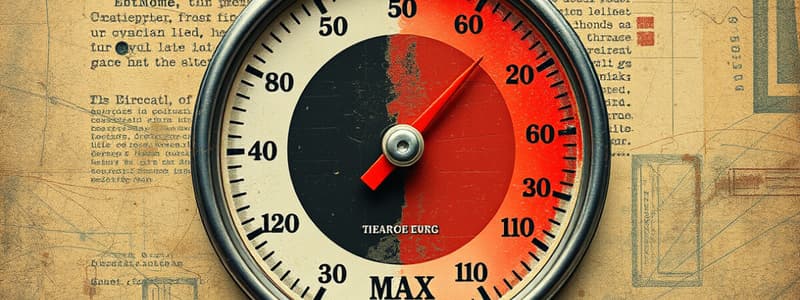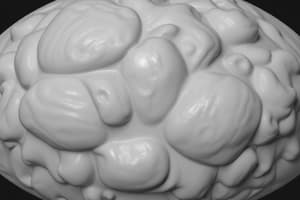Podcast
Questions and Answers
How can you check your calculation of the current temperature on a min/max thermometer?
How can you check your calculation of the current temperature on a min/max thermometer?
Compare the readings at either end of the red line.
What happens to the values as you move up the left side of a min/max thermometer?
What happens to the values as you move up the left side of a min/max thermometer?
They decrease.
If the current temperature on the left side reads 4°C, what will the right side current temperature be?
If the current temperature on the left side reads 4°C, what will the right side current temperature be?
4°C.
If 1 kg of iron and 1 kg of silver absorb equal amounts of heat, which will have a greater increase in temperature?
If 1 kg of iron and 1 kg of silver absorb equal amounts of heat, which will have a greater increase in temperature?
If two glasses of water are at the same temperature, what do you know about the kinetic energy of the particles in the glasses?
If two glasses of water are at the same temperature, what do you know about the kinetic energy of the particles in the glasses?
What is the difference between thermal energy and heat?
What is the difference between thermal energy and heat?
What is thermal energy?
What is thermal energy?
How does an increase in the total energy of the particles in a substance affect the thermal energy of the substance?
How does an increase in the total energy of the particles in a substance affect the thermal energy of the substance?
Describe how a thermometer works.
Describe how a thermometer works.
List the three different temperature scales.
List the three different temperature scales.
How do the units of the Celsius temperature scale compare to those of the Kelvin scale?
How do the units of the Celsius temperature scale compare to those of the Kelvin scale?
Which is a larger change in temperature: a change of 1 Celsius degree or 1 Fahrenheit degree? Explain.
Which is a larger change in temperature: a change of 1 Celsius degree or 1 Fahrenheit degree? Explain.
If a bathtub and a cup contain water at the same temperature, which will have more thermal energy? Why?
If a bathtub and a cup contain water at the same temperature, which will have more thermal energy? Why?
Flashcards
Min/Max Thermometer Reading
Min/Max Thermometer Reading
Compares values at the ends of the red line to check temperature.
Min/Max Thermometer Scale
Min/Max Thermometer Scale
Values decrease as you go up the left side of the thermometer.
Corresponding Temperature Reading
Corresponding Temperature Reading
Reading is consistent across both sides.
Specific Heat
Specific Heat
Signup and view all the flashcards
Comparing Temperature Increase
Comparing Temperature Increase
Signup and view all the flashcards
Kinetic Energy
Kinetic Energy
Signup and view all the flashcards
Thermal Energy
Thermal Energy
Signup and view all the flashcards
Heat
Heat
Signup and view all the flashcards
Thermal Energy
Thermal Energy
Signup and view all the flashcards
Increase in Thermal Energy
Increase in Thermal Energy
Signup and view all the flashcards
Thermometer Operation
Thermometer Operation
Signup and view all the flashcards
Primary Temperature Scales
Primary Temperature Scales
Signup and view all the flashcards
Temperature Scale Increment Size
Temperature Scale Increment Size
Signup and view all the flashcards
Study Notes
Temperature Measurement
- To verify the current temperature on a min/max thermometer, compare values at either end of the red line.
- As you ascend the left side of a min/max thermometer, the values decrease.
- The current temperature read on the left side directly corresponds to the right side; if it reads 4°C on the left, it will also be 4°C on the right.
Specific Heat and Temperature Change
- Iron's specific heat is higher than that of silver; therefore, when equal heat is absorbed by both, silver's temperature will increase more significantly.
Kinetic Energy in Water
- If two glasses of water are at the same temperature, the kinetic energy of the particles in both is equal.
Thermal Energy vs. Heat
- Thermal energy is defined as the total energy present in all particles of a substance.
- Heat is the movement of thermal energy from an area of higher temperature to one of lower temperature; it represents energy transfer rather than energy itself.
Understanding Thermal Energy
- The total energy of all particles within a substance is referred to as thermal energy.
- An increase in the particles' total energy results in an increase in the substance's thermal energy.
Thermometer Functionality
- Thermometers contain a liquid such as mercury or alcohol in a sealed tube.
- As temperature increases, the liquid expands due to particle motion, causing it to rise in the tube; cooling causes contraction and a drop in the liquid level.
Temperature Scales
- The three primary temperature scales are Fahrenheit, Celsius, and Kelvin.
- A change of 1°C is equivalent to a change of 1 K, underscoring their direct relationship.
Temperature Change Comparison
- A change of 1°C represents a larger temperature change than 1°F because there are 100 Celsius degrees between water's freezing and boiling points, compared to 180 Fahrenheit degrees.
Thermal Energy in Different Quantities
- A bathtub filled with water at the same temperature as that in a teacup contains greater thermal energy due to the larger number of water molecules present.
Studying That Suits You
Use AI to generate personalized quizzes and flashcards to suit your learning preferences.



